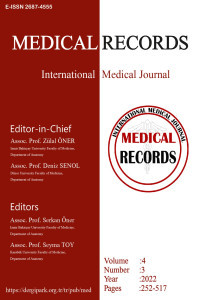Uşak İlinde Çocuklarda Üriner Sistem Enfeksiyonlarının Mikrobiyolojik ve Antimikrobiyal Profili
Microbiological and Antimicrobial Profile of Urinary System Infections in Children in Uşak
pediatrics, , urinary tract infecrions etiology, antibiotic resistansce,
___
- 1- Gurel S, Onal ZE, Akıcı N, Nuhoglu C. Correspondence of Priority between DMSA Scintigraphy and Voiding Cystourethrography in Children with Urinary Tract Infections. The Medical Journal of Haydarpaşa Numune Training and Research Hospital. 2015;55 (1): 22-30
- 2. Doern CD, Richardson SE. Diagnosis of urinary tract infections in children. Kraft CS, ed J Clin Microbiol 2016;54(9):2233–2242.
- 3. Wang J, He L, Sha J, Zhu H, Huang L, Zhu X, et al. Etiology and antimicrobial resistance patterns in pediatric urinary tract infection. Pediatr Int. 2018;60(5):418-422.
- 4. Jorgensen JH, Ferraro MJ. Antimicrobial susceptibility testing: a review of general principles and contemporary practices. Clin Infect Dis. 2009;49(11):1749–55.
- 5. Subcommittee on Urinary Tract Infection, Steering Comimittee on Quality Improvement and Management, Roberts KB. Urinary tract infection: clinical practice guideline for the diagnosis and management of the initial UTI in febrile infants and children 2 to 24 months. Pediatrics. 2011;128:595-610.
- 6. Yakubov R, van den Akker M, Machamad K, Hochberg A, Nadir E, Klein A. Antimicrobial Resistance Among Uropathogens That Cause Childhood Community-acquired Urinary Tract Infections in Central Israel. Pediatr Infect Dis J. 2017;36(1):113-115.
- 7. Gunduz S, Uludağ Altun H. Antibiotic resistance patterns of urinary tract pathogens in Turkish children. Glob Health Res Policy. 2018;16:3-10.
- 8. Vandepitte J, Engbaek K, Piot P, Heuck CC, et al. Basic laboratory procedures in clinical bacteriology. 2nd ed. Geneva: World Health Organization; 2003.
- 9. Versalovic J, Carroll KC, Funke G, Jorgensen JH, Landry ML, Warnock DW. (ed). Manual of clinical microbiology. 10th ed. American Society of Microbiology; 2011.
- 10. Pitout JD, Laupland KB. Extended-spectrum ß-lactamase producing Enterobacteriaceae: an emerging public-health concern. Lancet Infect. Dis. 2008;8:159–66.
- 11. Rezaee MA, Abdinia B. Etiology and Antimicrobial Susceptibility Pattern of Pathogenic Bacteria in Children Subjected to UTI: A Referral Hospital-Based Study in Northwest of Iran. Medicine. 2015;94(39): e1606.
- 12. McLellan LK, Hunstad DA. Urinary tract infection: pathogenesis and outlook. Trends Mol Med. 2016;22(11):946–57.
- 13. Kalal and Patel. Microbiological and Antimicrobial Profile of Urinary Tract Infection in Children from a Teaching Hospital in South India. J Pediatr Inf. 2017; 11: i19-i22
- 14. Konca C, Tekin M, Uckardes F, Akgun S, Almis H, Bucak IH, et al. Antibacterial resistance patterns of pediatric community-acquired urinary infection: Overview. Pediatr Int. 2017;59(3):309-315.
- 15. Yolbaş I, Tekin R, Kelekci S, Tekin A, Okur MH, Ece A et al. Community-acquiredurinary tractinfections in children: pathogens, antibiotic susceptibility and seasonal changes. Eur Rev Med Pharmacol Sci. 2013;17(7):971-6.
- 16. De Miranda ÉJP, De Oliveira GSS, Roque FL, Dos Santos SR, Olmos RD, Lotufo PA. Susceptibility to antibiotics in urinary tract infections in a secondary care setting from 2005-2006 and 2010-2011, in São Paulo, Brazil: data from 11,943 urine cultures. Rev Inst Med trop S Paulo. 2014;56:313–24.
- 17. Edlin RS, Copp HL. Antibiotic resistance in pediatric urology. Ther Adv Urol. 2014;6:54-61
- 18. Özçakar ZB, Yalçınkaya F, Kavaz A, Kadıoğlu G, Elhan AE, Aysev D, et al. Urinary infections owing to ESBL-producing bacteria: microorganisms change – clinical pattern does not. Act. Paediatr. 2011;100:61-4
- 19. Pourakbari B, Ferdosian F, Mahmoudi S, Teymuri M, Sabouni F, Heydari H, et al. Increase resistant rates and ESBL production between E. coli isolates causing urinary tract infection in young patients from Iran. Braz J Microbiol. 2012;43(2):766-9.
- 20. Uyar Aksu N, Ekinci Z, Dündar D, Baydemir C. Childhood urinary tract infection caused by extended-spectrum β-lactamase-producing bacteria: Risk factors and empiric therapy. Pediatr Int. 2017;59(2):176-180.
- 21. Akturk H, Sutcu M, Somer A, Karaman S, Acar M, Unuvar A, et al. Results of Four-Year Rectal Vancomycin-Resistant Enterococci Surveillance in a Pediatric Hematology-Oncology Ward: From Colonization to Infection. Turkish journal of hematology: official journal of Turkish Society of Haematology. 2016;33(3):244-7.
- 22. Shortridge D, Duncan LR, Pfaller MA, Flamm RK. Activity of ceftolozane-tazobactam and comparators when tested against Gram-negative isolates collected from paediatric patients in the USA and Europe between 2012 and 2016 as part of a global surveillance programme. Int J Antimicrob Agents. 2019;53(5):637-643.
- 23. Atmis B, Kara SS, Aslan MH. Community-acquired Pediatric Urinary Tract Infections Caused by Morganella Morganii. J Pediatr Res. 2020;7(2):121-5.
- 24. Kalaitzidou I, Ladomenou F, Athanasopoulos E, Anatoliotaki M, Vlachaki G. Susceptibility patterns of uropathogens identified in hospitalized children. Pediatr Int. 2019;61(3):246-251.
- Yayın Aralığı: Yılda 3 Sayı
- Başlangıç: 2019
- Yayıncı: Zülal ÖNER
Kastamonu İlinde Hepatit A Seroprevalansının Değerlendirilmesi i
Enis Fuat TÜFEKCİ, Büşra ÇALIŞIR, Melike YAŞAR DUMAN, Çetin KILINÇ
Çocuklarda Zor Entübasyon ile İlişkili Olabilecek Antropometrik Ölçümlerin Belirlenmesi
0-6 Yaş Arası Çocukların Ev Kazalarının Sıklığı ve Anne Güvenlik Önlemlerinin Tanı Düzeyleri
Dilek ENER, Mehmet Yavuz ÖZBEY
Dördüncü ve Beşinci Parmak Metakarpofalangeal Eklemde Kalsiyum Depolanması
Serhat EKREM, Harun KÖSE, Zeynep MARAŞ ÖZDEMİR, Kadir ERTEM
Balık Yağı Takviyeleri Kullanımı Benign Pediyatrik Epistaksisi Uzatır Mı?: Bir Olgu
Şeyda Tuba SAVRUN, Atakan SAVRUN
Foramen Stylomastoideum’un Kesin Konumu ve Fasiyal Sinir Bloğu için Klinik Önemi
Serdar BABACAN, Rohat BAYAT, Evren BÜYÜKFIRAT, Mustafa DENİZ
Sülük Tedavisi Sonrası Gelişen Churg Strauss Sendromu: Olgu Sunumu
Dilhan GUNAY, Miraç VURAL KESKİNLER
Gastrik Intestinal Metaplazi Sıklığı ve Helikobakter Pilori ile İlişkisinin Belirlenmesi
